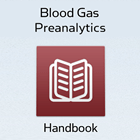Printed from acutecaretesting.org
October 2009
Assessment of acid base status - the physiochemical approach
Summarized from Morgan TJ. The Stewart approach - one clinician’s perspective. Clin Biochem Rev 2009; 30: 41-54 Author: Maciel A, Park M. A physiochemical acid-base approach for managing diabetic ketoacidosis. Clinics 2009; 64: 714-18.
Traditionally, interpretation of blood gas results for the assessment of acid-base status has been based on the Henderson-Hasselbalch equation, the central focus of which is the carbon dioxide – the bicarbonate buffer system. At its most reduced form the equation can be stated as “pH is proportional to the ratio of bicarbonate concentration to partial pressure of carbon dioxide”.
The concept contained in this reduced form of the equation that changes in pH of blood are determined by change in bicarbonate concentration (HCO3–) and pCO2 led to the familiar four classes of acid-base disturbance: respiratory acidosis, metabolic acidosis, respiratory alkalosis and metabolic alkalosis in which pCO2 is the respiratory component and bicarbonate the metabolic component.
Although this approach to acid-base pathophysiology continues to be well-rooted in clinical medicine, an alternative approach first proposed by Canadian physiologist Peter Stewart nearly 30 years ago is attracting increasing attention.
In a recently published review article the author describes in a very clear way the concepts that underpin Stewart’s once highly controversial alternative approach to acid-base balance, now often referred to as the physiochemical approach.
A useful introduction describes the controversies surrounding the development of the traditional approach to blood gas analysis prior to Stewart’s contribution, and thereby places his ideas in a historical context. Central to the physiochemical approach is the notion that three independent variables change the pH of blood: strong ion difference (SID), total concentration of non-volatile weak acids (ATOT) and pCO2.
The review includes an explanation of the theoretical basis for this assertion and all-important explanations of the two unfamiliar variables SID and ATOT, along with that of some other derived parameters, strong ion gap (SIG) and net unmeasured ions (NUI), used in the application of the physiochemical approach.
This is a complex subject, but the approach from the first principles that have been adopted by the author helps understanding.
Although many uncertainties remain about the diagnostic value of the physiochemical approach, there is a growing acceptance that it can provide clinically useful additional information to that provided by the traditional approach to acid-base assessment.
This is exemplified in a separate case study report of a patient suffering diabetic ketoacidosis. The clinicians responsible for this report explain how the physiochemical approach was applied with effect in the management of this patient.
May contain information that is not supported by performance and intended use claims of Radiometer's products. See also Legal info.
Acute care testing handbook
Get the acute care testing handbook
Your practical guide to critical parameters in acute care testing.
Download nowRelated webinar
Evolution of blood gas testing Part 1
Presented by Ellis Jacobs, PhD, Assoc. Professor of Pathology, NYU School of Medicine.
Watch the webinar








